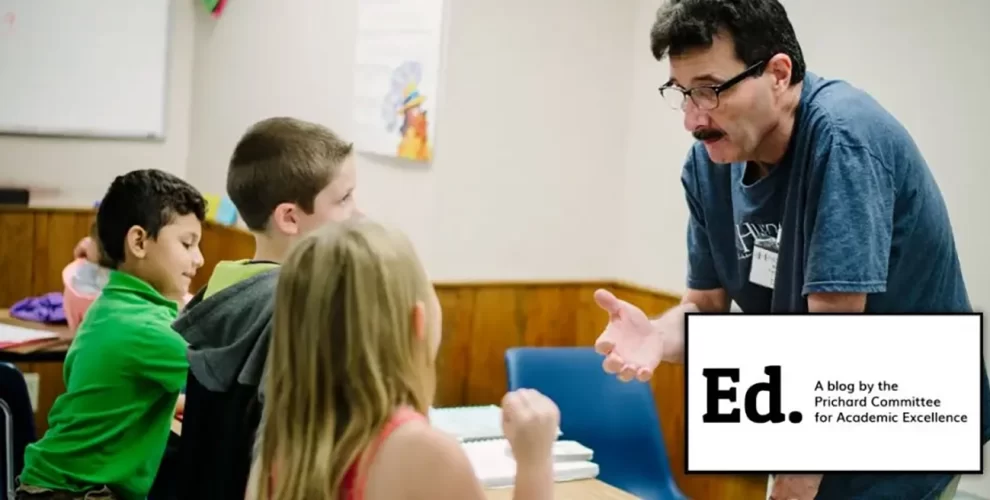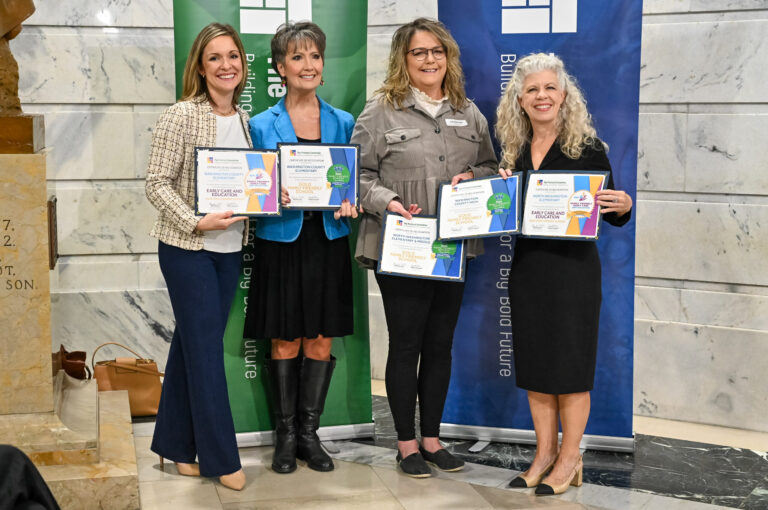AFTERSCHOOL TIME BOOSTS ACADEMICS, ENGAGEMENT

OCTOBER 2019 \ SPENCER COUNTY MIDDLE SCHOOLAt some point most every school day, Marissa Atha, a 7th grader at Spencer County Middle School, said she can’t wait for the final bell to chime.She finds math and science tough to absorb, but once school is out, she feels confident that she can get things straight and also have fun with friends — all before dinner.“How I do in class is improved,” Marissa said, crediting the school’s thriving afterschool program, Grizzlies Beyond the Bell, which everyone calls G.B.B.Four days a week, Marissa and her peers are able to work with teachers for an hour each afternoon to revisit fuzzy concepts, finish homework, retake tests, or wrestle with new concepts. The program also offers a snack, an hour in clubs created based on students’ interests, and, if needed, a ride back to their families. For Marissa and others, the program motivates through personal connections with the afterschool program staff, teachers who work with the program, high schoolers who assist, and community volunteers.“When I go to G.B.B., Ms. Karen (program director Karen Leff) asks about my current grades,” the 12-year-old said. “I hadn’t been doing well in math class along with science, and she just encourages me — ‘You need to retake that test’, or ‘You need to do your work,’ or ‘Come on Marissa, you need to start doing more stuff to get more productive.”“It works,” Marissa added. “They are so supportive and nice.”The G.B.B. program is a popular support. Last year, more than 550 of 650 students at Spencer County Middle stayed for the program at some point during the year. Day-to-day attendance averages about 150.STUDENTS IN A SERVICE CLUB called The Kindness Project guess one another’s answers on a quiz about personality traits.Principal Matt Mercer said the growth of the afterschool program tracks closely with significant academic gains by the school.“This program is at the center of everything we do,” he said.Since the afterschool program started six years ago, academic performance rose from the bottom third of middle schools to well above the state average. This fall, the school was one of 72 middle schools earning four stars or higher under the state’s new rating system, which measured 319 middle schools. Spencer County Middle was classified a “distinguished” school in the previous accountability system.”I don’t think that’s a coincidence,” Mercer said. “Our students started to buy into the idea of liking and enjoying and feeling safe at SCMS” as the afterschool program grew.Spencer County educators saw an opportunity to expand supports for students and families under the federal 21st Century Community Learning Centers program created to increase academic enrichment outside of school hours.Funds flow from the U.S. Department of Education to the Kentucky education department, which awards grants to school districts, community organizations and other eligible public and private groups.
The key to all of it is getting to know the kids.
— Program Director Karen Leff
Spencer County started with a $150,000 grant six years ago. Now, after an expansion grant and continuation funding, the budget is $200,000 per year with an eye toward making the budget sustainable for the district and school when grant funds end.The current combination of local and federal support funds 2 full-time staff members to organize and lead the program. It also pays 11 teachers to tutor students and lead club activities, 3 classified staff members who assist, and a group of 8 mentors from Spencer County High.In addition, the grant covers transportation to four pick-up locations where students meet family members after the program dismisses at 5:30 each afternoon. A four-week summer program is also funded through the federal grant.For Karen Leff, who has directed the program since it started, a goal is to make the bureaucratic structure of the program disappear behind an environment of close connection and engaging activities that keep things lively.“The key to all of it is getting to know the kids. We both come in early every day. We eat lunch with the kids, we interact, we go to their ballgames. We have that relationship with them,” she said of herself and the program’s data specialist, who works in the office with Leff. “I want it to be fun.”The sense of personal attention comes through. Seth Arterburn, a sixth grader who didn’t know about the program when he started school here this year after moving from Louisville, said the time built in for homework has been “quite helpful” with math, history and science work.Having a teacher on hand means questions get addressed quickly. A recent example involved understanding how to divide decimals. Seth said the teacher walked a group of students through the necessary steps. “He’ll always come around and help us and check it,” Seth said.
The growth of the afterschool program tracks closely with significant academic gains by the school, said Principal Matt Mercer.
Michelle Gross, a seventh-grade math teacher who leads a homework help session each day as well as the weekly Lego Club, said that the program means she can be a more effective teacher.“I’m able to sit down one-on-one with a kid, where, in a class of 32, it’s not that easy,” she said. “It enhances the learning in the classroom.”Parents said that the program is popular because it meets several needs at once — a place where kids are safe and happy while parents are still at work, a friendly atmosphere with peers and caring adults built around students’ interests, and academic assistance from those who know where students need help.“It’s right after school, so the material is still fresh in her brain,” parent Crystal Horner said of the homework help provided for her seventh-grade daughter.However, the tutoring is not the greatest contribution the program makes for her daughter, she noted. “G.B.B. has given her this place of belonging, and she loves it. In middle school, I think it’s hard for our children to find their place — they’re trying to find out who they are and where they belong.” Horner said those issues are more easily navigated with the added time and supports.Building a vibrant culture has been a chief goal of the afterschool program. A daily hour of club time provides many ways to show new approaches. The district superintendent has led the Archery Club since the program started. Principal Mercer leads a weekly Running Club. Among the many options are the Sewing Club, the Video Game Club, and the Farm Club, which recently hatched chicks and will build a coop. Seth, the seventh grader, said the Board Game Club’s competitions can spill over into future meetings.The popularity of the clubs has expanded parent and community partnerships, including a parent-led Robotics Club that now competes at the state level.Mercer, the principal, said that G.B.B. has become a leading example of the school’s goals. “It is part of the DNA of Spencer County Middle School. We’re really big schoolwide on culture — relationships first, high expectations, celebrating achievement, promoting leadership,” he said. “It definitely is a part of our culture, and I think it’s part of our community’s culture.”KAREN LEFF, DIRECTOR of the Grizzlies Beyond the Bell program, talks with students during the snack break after school dismisses.Redefining a tricky slice of the day when parents are still occupied with work but young students are out of school fills obvious gaps especially in a bedroom community where many adults commute.“It works out perfect for us,” said Kabrel Woods, who lives in Taylorsville and works in nearby Bullitt County. She makes it home ahead of her elementary school daughter, while her husband finishes work in time to pick up their seventh grader at school when the program ends at 5:30.Beyond the family-friendly schedule, Woods said that the individual attention the program provides also creates an important point of contact. She communicates regularly with Leff, the program director. “It’s nice to have somebody there at the school that I know is looking out for him,” Woods said.Leff is a ready conduit for parents, students, teachers, administrators and people across the community. She said the afterschool program is about finding ways to support and enhance what students and the school can accomplish.“We say all the time that we need to be who we needed when we were younger,” she said.Seventh grader Marissa Atha doesn’t want to think what school would be like without the opportunities that the afterschool program provides at Spencer County Middle.“The program — it just helps me,” she said. “If I went to a different school, I guess I’d be complaining about my school work because it would be so much harder without knowing I get to go to G.B.B. after this; that I get to do Volleyball Club after this; that I actually can get my work done without my sister interrupting me. I think I would just be totally upset.”
\
ISSUES IN EXTENDED TIME
Part of the Kentucky Education Reform Act of 1990 was a realization that schools should build extra support for students in time beyond the normal school day. Understanding how your school or district envisions and plans for learning experiences beyond school hours can be a significant step toward improving outcomes. Some questions that might spark a local conversation:\ What programs are currently offered locally outside of school hours? That can mean regular tutoring, afterschool programs, extended school services, summer programs, evening classes, and even time before school begins. How well are those programs publicized and linked to a mission to improve or expand student learning? Ask about how community agencies and programs beyond the school system are connected to school efforts and input.\ How do existing options beyond school hours link to Kentucky Academic Standards? Do the programs get input from students’ teachers on how individuals are progressing and topics where additional attention might be most productive?\ Is there a plan for expanding to linking existing options or seeking ways to create new opportunities for students and families? How is community input sought in such conversations and planning? Are students’ and family voices part of the process?At Spencer County Middle School, student surveys are a common tool for getting feedback on the afterschool program and how it can be more effective. Club offerings are developed in collaboration with students.\ The state education department offers a basic explanation of Extended School Services programs created to help schools provide ongoing help. The link explains services covered by E.S.S. funds. The Prichard Committee also offers a summary of Kentucky’s supports for student learning.\ Information on the federal 21st Century Community Learning Center programs and funding in Kentucky is available from the state education department. To be eligible for the grants, schools must fall within family income limits. A listing of Kentucky grant recipients for the current school year can be downloaded from the state.\ The Afterschool Alliance is a national group based in Washington, D.C., that provides information about approaches and options for expanding student learning. A summary cites evidence of the effectiveness of quality afterschool programs. Among the key benefits are closing achievement gaps, increasing school attendance and reducing disciplinary incidents. Long-term, programs show increased earning potential for students and helping families reduce time and expenses on logistics and care between the time school ends and adults return home from work.Each month, the BRIGHT SPOTS blog showcases impressive learning in Kentucky schools.COMING SOON \CREATING STRONG LEARNING ENVIRONMENTS at Kentucky’s Governor’s Scholars Program.ABOUT SPENCER COUNTY MIDDLE \ENROLLMENT: 650 in 6-8KEY DEMOGRAPHICSRACE: 9.5% minorityINCOME: 46% eligible for free/reduced price mealsDATA NOTES\ Spencer County Middle was named a School to Watch in 2018 by the National Forum to Accelerate Middle Grades Reform. The team that visited the school mentioned the lively afterschool program as one highlight.\ On 2019 K-PREP reading tests, 71.4 percent of Spencer County students scored proficient or better, 11 percentage points above the state average. Among SCMS students who qualified for free- or reduced-price meals, 63 percent scored proficient or better. On 2019 state math tests, 54 percent of Spencer County pupils scored proficient or distinguished, 4 percentage points above the state average. Among SCMS students who qualified for free- or reduced-price meals, 43.8 percent scored proficient or better.\ Looking at state test scores before the afterschool program was added at SCMS, the school lagged behind the state average on the reading test. On that 2011 test, the school’s average was 14 percentage points behind the state average for the number of students scoring proficient or above. On the state math test that year, the school scored just above the state average proficiency rate.




